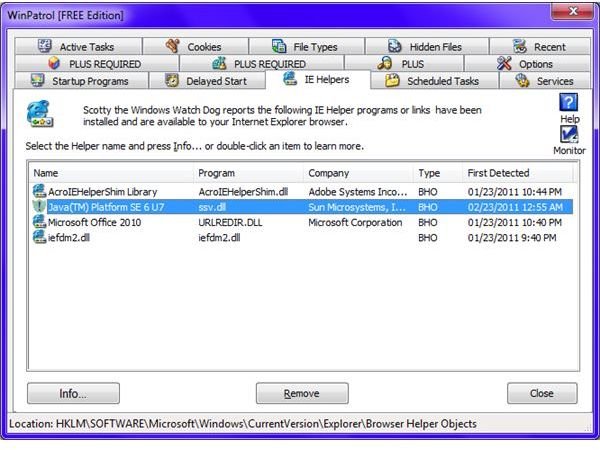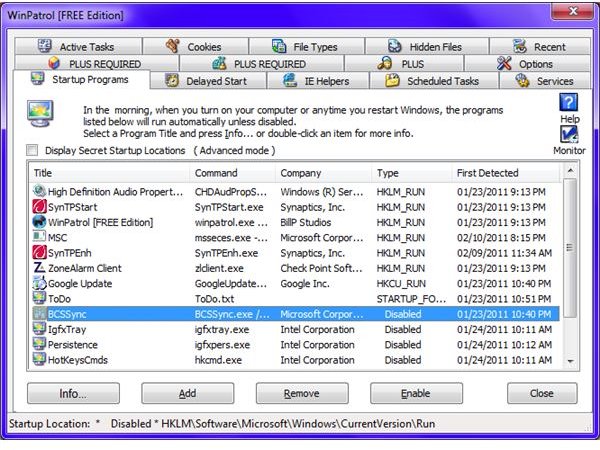Using WinPatrol - Tutorials for Optimizing Your Computer
Disable UAC Before Using WinPatrol
Winpatrol monitors all the major processes running on your computer. When it detects a change in any program or when a process is added to the list of monitored processes, it alerts you and asks you if you wish to allow the change or addition. However, the Windows UAC suppresses this alert and presents its own dialog alerting you that a program is trying to change something. The UAC alert is not clear and sometimes you don’t even know that it is talking about WinPatrol.
When UAC is turned on, all you get is a message saying some program is trying to make a change. It won’t tell you what action WinPatrol is attempting. The actions can be anything: asking you whether you wish to change the homepage of Internet Explorer or asking you if you wish to allow a new startup process. You won’t be able to view the actual WinPatrol message unless UAC is turned off.
To turn off UAC in Windows 7,
- Open Control Panel
- Double click on User Accounts to open it
- Click to open your user account.
- Click on the link saying Change User Account Control Settings
- Drag the slider to bottom where it says Never Notify
WinPatrol offers better security than the UAC so you need not feel insecure after disabling it.
Note: This section is not applicable to Windows XP and lower versions.
Features of WinPatrol

WinPatrol has several features for protecting your computer and enhancing its functionality, including the speed of the computer. When you open WinPatrol, you can see several tabs: each related to a particular set of components/actions for the computer. For example, the IE Helpers tab shows you what all add-ons and toolbars are installed for the Internet Explorer. It shows even the ones that are not visible via Manage Add-ons in the Tools menu of IE.
Following are some of the components that you can manage through WinPatrol
- Internet Explorer Helpers (Add-ons and Toolbars)
- Startup Items
- Services Running on the Computer
- Cookies
- Scheduled Tasks
Using WinPatrol to Manage Internet Explorer
Open WinPatrol and click the IE Helpers tab to see the components of Internet Explorer on your computer. The IE Helpers tab lists all the components present for IE. It also lists the components that are otherwise invisible when you open the Manage Add-ons window using the Tools menu of Internet Explorer.
You can speed up Internet Explorer from here. Just check out the add-ons/toolbars present and disable the ones you don’t want to use. You can also click on the Remove option to remove the unwanted components.
If you are not sure about a component, double click on the component name. WinPatrol will open a web page where it shows more information about the IE component. If you still don’t figure it out, you can simply disable the component and see if your browser is working properly. If it is, you can leave the component disabled. If disabling the IE component creates problems, you can always enable it using WinPatrol.
Note that the program also keeps a watch on the homepage. If any program changes the homepage, it alerts you and asks you if you wish to keep the new homepage. You can click on Yes to retain it or on No to change the IE settings to the previous homepage.
Some programs add their own components forcefully. Others add some toolbars when you install them. You can remove those components from the IE Helpers tab on WinPatrol.
Manage Startup Programs to Speed Up Computer

You can also select which startup programs to run when Windows boots. When you open WinPatrol, it opens the Startup programs tab. You can see the list of all startup programs here.
To know about a startup process, select the process and click on Info. You can also double click the process. A new webpage opens and shows you information about the process. In the free version of WinPatrol, sometimes you may not get the information about the process. You can always type in the process name in Google and obtain information about it.
Once you decide whether to disable or remove the startup program, just select it by clicking on it and then click Disable or Remove per your wish.
You can also add your own startup program using the Startup Programs tab. To add a program, click on the Add button. The Open File dialog appears. Browse to the program you wish to open at Windows start and click OK. You can see the program in the Startup Programs tab.
Delaying Startup Programs

You can also delay startup programs so that you can get faster access to the desktop. Too many startup programs make you wait longer before you can click on an icon upon Windows boot. When you delay a startup program, you can get to the Windows desktop first while the WinPatrol loads delayed programs in the background - after the time delay you specify.
You can see the delayed startup programs under the tab named Delayed Start. To move a program from Startup tab to Delayed Start, right click on the program and select Move to Delayed Start List. WinPatrol will not ask you the time by which you wish to delay the program from loading at this point.
To specify the delay, go to the Delayed Start. Right click on the program whose timings you want to change and then click on Delay Startup Options. A dialog appears where you can specify the time and the mode (maximized or minimized) for the program.
To remove the delay, right click on the program under Delayed Start and select Restore to Startup Programs list.
The above are the most used functions in WinPatrol. You can also organize the Windows Services the same way you organize the Startup programs. However, you cannot delay the Windows services. There is no option because those services load in a particular order and are interdependent.
Other than the Windows Services, you can also use WinPatrol to add, remove or disable scheduled tasks. The method is the same as adding or disabling/removing a startup program.
Now that you have gone through these WinPatrol tutorials, you can just go ahead and download a free copy to enhance the functioning of your computer.
Related Reading
WinPatrol 2011 Review at BrightHub
References
Screenshots by author, from WinPatrol
WinPatrol website, https://winpatrol.com
